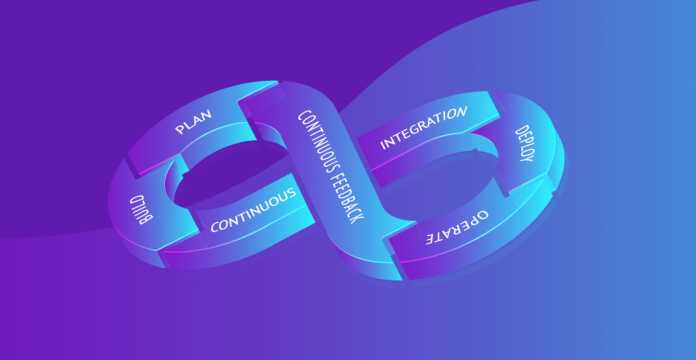
DevOps and continuous delivery have been adopted by multiple companies over the globe to optimize their software development process and gain a competitive advantage. Among them are some tech giants like Amazon, which is on a record of making changes to the production every 11.6 seconds on average, and Facebook which releases to production twice a day.
Even then, many managers and executives aren’t convinced of the benefits of this process and deem the adoption too tedious to undergo.
In this article, we will discuss some important aspects of continuous delivery and its role in the DevOps methodology.
What is Continuous Delivery?
Continuous Delivery is the capacity to get variations of all types—including new features, configuration modifications, fault fixes, and experiments—into production, or into the hands of users, cautiously and promptly in a sustainable way.
The aim is to make deployments—whether of a large-scale administered system, a complicated production situation, an implanted system, or an app—predictable, regular affairs that can be executed on demand.
All this is accomplished by assuring that the code is continuously in a deployable state, even in the appearance of teams of thousands of developers producing changes regularly. We therefore entirely exclude the alliance, testing, and solidification phases that traditionally followed “dev complete”, as well as code freezes.
Why Continuous Delivery?
It is usually believed that if we need to deploy software more often, we must acquire lower levels of durability and dependability in our systems. Peer-reviewed analysis proves that this is not the case—high-performance teams consistently release services quicker and more reliably than their low-performing opponent.
This is correct even in profoundly controlled domains such as commercial services and government. This ability gives an unbelievable competing advantage to organizations that are ready to invest the energy to pursue it.
The practices at the core of continuous Delivery assist us in achieving numerous essential benefits:
Low-Risk Releases
The primary purpose of continuous delivery is to make software deployments painless, low-risk cases that can be implemented at any time, on-demand. By using patterns such as blue-green deployments, it is comparatively straightforward to accomplish zero-downtime implementations that are undetectable to users.
Faster Time to Market
It’s not surprising for the synthesis and test/fix phase of the current phased software delivery lifecycle to spend weeks or even months. When teams operate mutually to automate the build and deployment, background provisioning, and regression testing methods, developers can include synthesis and regression testing into their regular work and remove these phases. We further avoid the massive amounts of re-work that plague the phased strategy.
Higher Quality
When developers have automated tools that identify regressions within seconds, teams are relieved to concentrate their effort on user study and higher-level testing actions such as exploratory testing, usability testing, and performance and safety testing. By creating a deployment pipeline, these actions can be done continuously during the delivery process, assuring quality is built into products and services from the start.
Lower Costs
Any prosperous software product or service will grow significantly for its lifetime. By funding in build, test, deployment, and setting automation, we considerably reduce the price of making and delivering incremental adjustments to the software by reducing many of the established costs connected with the release process.
Better Products
Continuous Delivery makes it commercial to work in small batches. This implies that we can get feedback from users during the delivery lifecycle based on running software. Procedures such as A/B testing allow us to take a hypothesis-driven way to product growth whereby we can examine ideas with users before making out whole features. This signifies that we can bypass the 2/3 of characteristics we create that produce zero or negative value to the businesses.
Happier Teams
Peer-reviewed analysis has revealed continuous Delivery makes deliveries less uncomfortable and lessens team burnout. Moreover, when we deliver more often, software delivery teams can involve more actively with users, see which ideas work and which don’t, and understand first-hand the results of the work they have done. By eliminating the low-value disturbing activities connected with software delivery, we can concentrate on what we care about most—continuously pleasing our users.
Principles of Continuous Delivery
There are five principles at the core of continuous Delivery:
- Build quality software
- Work in little batches
- Computers execute repetitive tasks; people resolve problems
- Relentlessly seek continuous growth
- Everyone is responsible
It’s simple to get bogged down in the details of performing continuous Delivery—devices, structure, methods, politics—if you find yourself misplaced, attempt revisiting these principles and you might find it encourages you to refocus on what’s necessary.
Foundations of Continuous Delivery
Continuous Delivery is based on three foundations: comprehensive configuration management, continuous integration, and continuous testing.
Configuration Management
Automation performs a vital role in assuring; that we can deliver software repeatably and surely. One important goal is to take constant manual methods like build, deployment, regression testing, and base provisioning, and automate them.
To accomplish this, we need to check everything required to execute these methods, including source code, test and deployment scripts, base and application configuration data, and the several libraries and packages we depend upon. We further need to make it straightforward to question the current—and traditional—state of our environments.
Continuous Integration
Blending the work of various developers is hard. Software systems are complicated, and an intuitively easy, self-contained switch to a single file can have unintended outcomes that jeopardize the correctness of the system.
As a result, a few teams have developers work separated from each other on their branches, both to keep trunk/master stable, and to block them from stepping on each other’s toes.
Continuous Testing
The solution to creating quality in our software is making sure we can get quick feedback on the consequence of changes. Traditionally, considerable use was made of manual examination of code modifications and manual testing (testers following documentation explaining the steps needed to test the multiple functions of the system) to illustrate the accuracy of the system. This kind of testing was usually executed in a phase following “dev complete”.
If this seems too good to be true, keep in mind: that continuous Delivery is not magic. It’s regarding continuous, regular improvement—the constant development of seeking higher performance by succeeding the heuristic “if it hurts, do it more often, and bring the pain forward.”
This continuous and regular improvement of DevOps processes takes time and key individuals, and enterprise teams need to be aware of the latest best practices being used in the DevOps methodology. Training these individuals in widely-recognized DevOps Certification courses will help both the workforce and the organization to achieve greater DevOps maturity levels.
Some of the popular DevOps courses that professionals can take up are:














